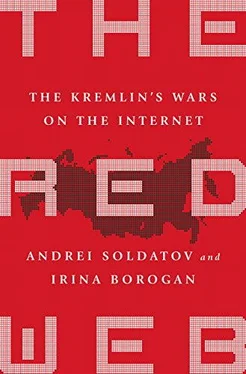Андрей Солдатов - The Red Web - The Struggle Between Russia's Digital Dictators and the New Online Revolutionaries
Здесь есть возможность читать онлайн «Андрей Солдатов - The Red Web - The Struggle Between Russia's Digital Dictators and the New Online Revolutionaries» весь текст электронной книги совершенно бесплатно (целиком полную версию без сокращений). В некоторых случаях можно слушать аудио, скачать через торрент в формате fb2 и присутствует краткое содержание. Город: New York, Год выпуска: 2017, ISBN: 2017, Издательство: PublicAffairs, Жанр: История, Политика, Интернет, Публицистика, на английском языке. Описание произведения, (предисловие) а так же отзывы посетителей доступны на портале библиотеки ЛибКат.
- Название:The Red Web: The Struggle Between Russia's Digital Dictators and the New Online Revolutionaries
- Автор:
- Издательство:PublicAffairs
- Жанр:
- Год:2017
- Город:New York
- ISBN:978-1-61039-57-3-1
- Рейтинг книги:3 / 5. Голосов: 1
-
Избранное:Добавить в избранное
- Отзывы:
-
Ваша оценка:
- 60
- 1
- 2
- 3
- 4
- 5
The Red Web: The Struggle Between Russia's Digital Dictators and the New Online Revolutionaries: краткое содержание, описание и аннотация
Предлагаем к чтению аннотацию, описание, краткое содержание или предисловие (зависит от того, что написал сам автор книги «The Red Web: The Struggle Between Russia's Digital Dictators and the New Online Revolutionaries»). Если вы не нашли необходимую информацию о книге — напишите в комментариях, мы постараемся отыскать её.
The Red Web: The Struggle Between Russia's Digital Dictators and the New Online Revolutionaries — читать онлайн бесплатно полную книгу (весь текст) целиком
Ниже представлен текст книги, разбитый по страницам. Система сохранения места последней прочитанной страницы, позволяет с удобством читать онлайн бесплатно книгу «The Red Web: The Struggle Between Russia's Digital Dictators and the New Online Revolutionaries», без необходимости каждый раз заново искать на чём Вы остановились. Поставьте закладку, и сможете в любой момент перейти на страницу, на которой закончили чтение.
Интервал:
Закладка:
The real beneficiary on June 10 was Putin’s political machine, the All-Russia People’s Front, and Kirill Varlamov. The genuine Internet market leaders were invited not to talk to Putin but to lend legitimacy to a government-funded pet project. And they did.
Although Yandex had once resisted pressure from the Kremlin, now it gave some ground. On September 12, 2014, Yandex announced that the company had agreed to formally register three of its online services—Yandex’s cloud service, its social network Moi Krug, and its mail system. They were put on a special list at Roskomnadzor consisting of online services required to keep users’ metadata for six months and to provide remote access to this data for the Russian security services. Mail.ru and VKontakte were also included on the list. [19] “Yandex Is Included in the Register of the Organizers of Dissemination of Information,” Rublacklist, September 12, 2014, http://rublacklist.net/8598 .
The scope of SORM had just expanded.
Yandex also attempted to tread carefully in the minefield of the Ukraine war. In March the service started offering different maps of Ukraine for Russian and Ukrainian users. The Russians would see a map showing Crimea as part of Russia, while a user in Ukraine would see the peninsula as still part of Ukraine. Yandex explained it by saying Crimea would be shown according to the official position of the country in which the map was viewed. [20] See www.blog.yandex.ru/post/77678 .
The Kremlin pressure to control the Internet was not always visible. It did not always appear in black-and-white threats. Sometimes the battle was waged in the mists. Those who believed in keeping the Internet out of the hands of the state tried to survive any way they could. Andrei Kolesnikov learned the game firsthand, and he was a very good player. CEO of an NGO that had been set up in 2001 to oversee Internet domain names, Kolesnikov has a long history with the Russian Internet; in 1992 he was one of eight people who signed the agreement that established the domain .ru. He was present at the meeting with Putin in December 1999, and he also attended the meeting with Putin in June 2014, though this time he was not invited to join the panel.
Kolesnikov was the first Russian expert to join ICANN’s governing bodies, and he was acutely aware of the Kremlin’s ideas about the Internet and what the Kremlin thought of NGOs as a whole. To avoid interference, he devoted a lot of time to attending public meetings on Internet security and offered repeatedly to be a technical expert to people who were in charge of setting policy on the Internet. His position was fragile. When Andrei visited him in September 2014, Kolesnikov argued with great fervor that repressive laws were, in fact, in “a parallel reality,” and they had no impact on the Internet at all. After half an hour of wrangling, he insisted that what the authorities had done to the Internet was entirely immaterial: “Look, did it affect your morning coffee?” [21] Andrei Kolesnikov, interview with authors, September 2014.
But the next morning brought disturbing news. The business daily Vedomosti exposed a Kremlin plan to gather the Russian Security Council, the advisory group to the president on security, in three days to discuss the option of shutting the country off from the global Internet in case of an emergency.
The centralized structure of the Russian Internet has led the authorities to believe that this was entirely possible; international traffic could be cut off either by the operators that control cross-border fiber-optic cables or at the Internet exchange points, where the international traffic joins the national Internet.
Even two decades after the collapse of the Soviet Union, Russian telecommunications remain largely centralized. Russia is connected to the outside world by fiber-optic cables, most of them laid by five Russian national operators, with the state-controlled Rostelecom enjoying the largest Internet backbone network in the country. Russia has only a dozen Internet exchange points (compared with more than eighty in the United States). [22] International Telecommunication Union, Internet Exchange Points (IXPs), World Telecommunication Policy Forum, May 14–16, 2013, www.itu.int/en/wtpf-13/Documents/backgrounder-wtpf-13-ixps-en.pdf .
And nearly half of the Russian Internet traffic passes through one of them, MSK-IX. The MSK-IX itself is based on the premises of the M9 phone exchange, which is owned by Rostelecom. (In January 2015 Rostelecom took over the MSK-IX, too.)
The geography of Russia doesn’t help. Although most of the world’s Internet traffic is passed via underwater cables, Russia connects with the West through the terrestrial cross-border fiber-optic cables laid from Moscow to St. Petersburg to Helsinki and Stockholm, and only recently did Rostelecom lay cables in a new direction, from Moscow to Frankfurt, Germany. In the east there are also some lines to China, Japan, and Iran, but overall the connections to the outside world are sparse.
Although it didn’t get as much attention, the Security Council also wanted to talk about a second option—to hand over the powers of administering Russian domains from Kolesnikov’s center to the government. If approved, it would mean that all Russian domains were under direct government control—or, rather, direct control of most websites in the country.
This time the initiative was not approved, but the message was strong and clear.
In 2014 Putin had one big secret he wanted to keep: Russian troops were in Ukraine. The Russian security services hunted down people around the country who tried to expose Putin’s secret, relying on the same technology the secret police had used almost seventy years earlier.
On April 17, 2014, Svetlana Davydova heard something on the street in the city of Vyazma, about 150 miles west of Moscow, and grabbed her phone. She was a mother of six children and pregnant with the seventh. She knew that outside the small town the Russian military intelligence service had a base, and she had just overheard talk at a bus stop that small groups of officers were being sent to Moscow and then Ukraine.
At that moment Russia was backing an undeclared war by Ukrainian separatists. Davydova had no access to secret information about the military unit; she simply overheard what people were saying on their cell phones at the bus stop. She was very interested in events in Ukraine and personally opposed to the Russian military presence there. She told her husband, Anatoly, what she had heard—and what it might mean. Then she wrote down what she knew.
That day, around 2:00 p.m., she called a hotline to the embassy of Ukraine in Moscow on her cell phone. She told the embassy she had information about the deployment of Russian military intelligence officers to Ukraine, and not much more. Nine minutes later the first secretary of the embassy called her back and asked her to provide details. Davydova relayed all she knew—just rumors she had heard on the street.
Davydova didn’t know it, but the FSB was monitoring the hotline, and the Russian security service had recorded her voice during the call to the embassy. The FSB immediately went to work to identify who she was. They had no difficulty—Davydova’s phone number was easily traced.
Then nothing happened for a while. Davydova was not questioned about the call. The war in Ukraine grew more intense.
Six months later Davydova gave birth to a baby girl. In two months, on January 21, 2015, there was a knock at the door of her apartment, and when Anatoly opened it, a group of special operations soldiers dressed in black burst in. The group was led by a top FSB official sent from Moscow. Davydova was detained, taken away, and the officers searched her small apartment, taking her computer, notebooks, and other materials as the family looked on. Davydova was brought directly to Moscow’s Lefortovo prison, the main prison the FSB used for high-profile investigations and detentions. She was frightened and worried, not least of all about the two-month-old baby she had been torn away from.
Читать дальшеИнтервал:
Закладка:
Похожие книги на «The Red Web: The Struggle Between Russia's Digital Dictators and the New Online Revolutionaries»
Представляем Вашему вниманию похожие книги на «The Red Web: The Struggle Between Russia's Digital Dictators and the New Online Revolutionaries» списком для выбора. Мы отобрали схожую по названию и смыслу литературу в надежде предоставить читателям больше вариантов отыскать новые, интересные, ещё непрочитанные произведения.
Обсуждение, отзывы о книге «The Red Web: The Struggle Between Russia's Digital Dictators and the New Online Revolutionaries» и просто собственные мнения читателей. Оставьте ваши комментарии, напишите, что Вы думаете о произведении, его смысле или главных героях. Укажите что конкретно понравилось, а что нет, и почему Вы так считаете.












